
Mayda Insula is an island in the Kraken Mare, a body of liquid composed primarily of methane, on Saturn's largest moon Titan. Mayda Insula is the first island (insula) to be named on a planet or moon other than Earth.

Mayda Insula is an island in the Kraken Mare, a body of liquid composed primarily of methane, on Saturn's largest moon Titan. Mayda Insula is the first island (insula) to be named on a planet or moon other than Earth.
Mayda Insula was discovered by the Cassini–Huygens mission to Saturn. Its name was approved by the International Astronomical Union Working Group for Planetary System Nomenclature on April 11, 2008, [1] becoming the first named island on a planetary body other than earth, and the largest. [2] NASA notes, however, that the possibility Mayda Insula is actually peninsular (i.e., connected to the mainland by a strip of land) cannot be conclusively ruled out. [3] All of the insulae on Titan have been named for legendary islands and "Mayda Insula" was derived from the legendary island Mayda which was thought to exist in the northeastern Atlantic Ocean. [2] Its name was approved the same day as the names of Kraken Mare and Ligeia Mare. [1]
Mayda Insula lies in the northern end of the Kraken Mare near Titan's north pole. [4] The island has a northernmost latitude of 80.3 degrees north and a southernmost latitude of 77.4 degrees north; it has a westernmost longitude of approximately 321.2 degrees west and an easternmost longitude of 302.7 degrees west. [5] The island is 168 kilometres (104 mi) wide at its widest point. [5] Its dimensions are approximately 90 by 150 kilometres (56 by 93 mi), about the same size as the Big Island of Hawaii. [3]
The highest point of the interior of Mayda Insula is approximately 1,200 metres (3,900 ft) above its shoreline. [6] Slopes are relatively mild at approximately 1.5 degrees on average, though they can approach 5 degrees in some locations. [6] Radar images of Titan's surface show that Mayda Insula's coasts display evidence of being changed by fluvial and lacustrine processes. [7] Analyses of these fluvial features suggested that approximately 2 km3 of material has been eroded from Mayda Insula and deposited elsewhere in the Kraken Mare basin. [7]
Mayda Insula features in Michael Carroll's novel On the Shores of Titan's Farthest Sea: A Scientific Novel. The 39th chapter of the book is titled "The Hunchback of Mayda Insula". [8]
The extreme metal band, High Priest of Saturn released an eponymous album in 2013 which has a song titled On Mayda Insula. Regarding the song, they said "drowning in Kraken Mare is a metaphor for being overcome by fear and anxiety while Mayda Insula is a safe haven where you can find peace" [9] . Kraken Mare is also a song on the album.
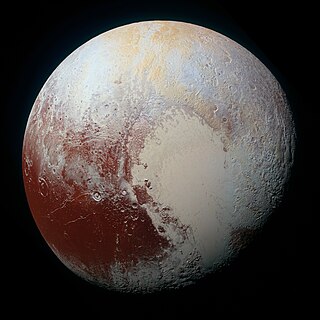
Planetary nomenclature, like terrestrial nomenclature, is a system of uniquely identifying features on the surface of a planet or natural satellite so that the features can be easily located, described, and discussed. Since the invention of the telescope, astronomers have given names to the surface features they have discerned, especially on the Moon and Mars. To found an authority on planetary nomenclature, the International Astronomical Union (IAU) was organized in 1919 to designate and standardize names for features on Solar System bodies.

Titan is the largest moon of Saturn and the second-largest in the Solar System. It is the only moon known to have an atmosphere denser than the Earth's, and is the only known object in space other than Earth on which clear evidence of stable bodies of surface liquid has been found. Titan is one of the seven gravitationally rounded moons of Saturn and the second-most distant among them. Frequently described as a planet-like moon, Titan is 50% larger than Earth's Moon and 80% more massive. It is the second-largest moon in the Solar System after Jupiter's moon Ganymede, and is larger than Mercury, but only 40% as massive due to Mercury being made of mostly dense iron and rock, while a large portion of Titan is made of less-dense ice.

Prometheus is an inner satellite of Saturn. It was discovered on 24 October 1980 from photos taken by the Voyager 1 probe, and was provisionally designated S/1980 S 27.

The moons of Saturn are numerous and diverse, ranging from tiny moonlets only tens of meters across to the enormous Titan, which is larger than the planet Mercury. There are 146 moons with confirmed orbits, the most of any planet in the solar system. This number does not include the many thousands of moonlets embedded within Saturn's dense rings, nor hundreds of possible kilometer-sized distant moons that were seen through telescopes but not recaptured. Seven Saturnian moons are large enough to have collapsed into a relaxed, ellipsoidal shape, though only one or two of those, Titan and possibly Rhea, are currently in hydrostatic equilibrium. Three moons are particularly notable. Titan is the second-largest moon in the Solar System, with a nitrogen-rich Earth-like atmosphere and a landscape featuring river networks and hydrocarbon lakes. Enceladus emits jets of ice from its south-polar region and is covered in a deep layer of snow. Iapetus has contrasting black and white hemispheres as well as an extensive ridge of equatorial mountains among the tallest in the solar system.

Xanadu is a highly reflective area on the leading hemisphere of Saturn's moon Titan. Its name comes from an alternate transcription of Shangdu, the summer capital of the Yuan dynasty established by Kublai Khan and made famous by Samuel Taylor Coleridge.
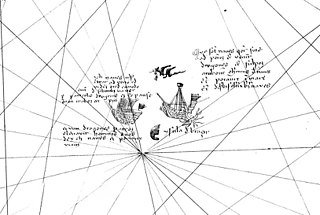
Mayda is a non-existent island in the North Atlantic that has been shown on several published maps at various points in history. It was most often represented as being crescent-shaped and its position has varied widely over time. Early maps drew the island west of Brittany and southwest of Ireland, but it later moved towards the Americas.

Carolyn C. Porco is an American planetary scientist who explores the outer Solar System, beginning with her imaging work on the Voyager missions to Jupiter, Saturn, Uranus and Neptune in the 1980s. She led the imaging science team on the Cassini mission in orbit around Saturn. She is an expert on planetary rings and the Saturnian moon, Enceladus.

Lakes of liquid ethane and methane exist on the surface of Titan, Saturn's largest moon. This was confirmed by the Cassini–Huygens space probe, as had been suspected since the 1980s. The large bodies of liquid are known as maria (seas) and the small ones as lacūs (lakes).
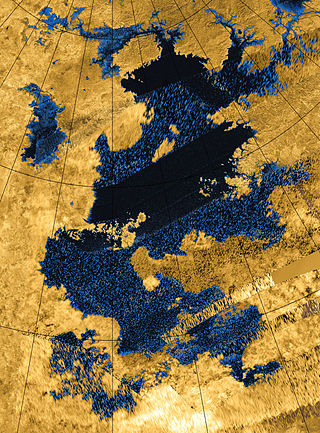
Kraken Mare is the largest known body of liquid on the surface of Saturn's moon Titan. It was discovered by the space probe Cassini in 2006, and was named in 2008 after the Kraken, a legendary sea monster. It covers an area slightly bigger than the Caspian Sea on Earth, making it the largest known lake in the Solar System.

Ligeia Mare is a lake in the north polar region of Titan, the planet Saturn's largest moon. It is the second largest body of liquid on the surface of Titan, after Kraken Mare. Larger than Lake Superior on Earth, it is mostly composed of liquid methane, with unknown but lesser components of dissolved nitrogen and ethane, as well as other organic compounds. It is located at 78° N, 249° W, and has been fully imaged by the Cassini spacecraft. Measuring roughly 420 km (260 mi) by 350 km (217 mi) across, it has a surface area of about 126,000 km2, and a shoreline over 2,000 km (1,240 mi) in length. The lake may be hydrologically connected to the larger Kraken Mare. Its namesake is Ligeia, one of the sirens in Greek mythology.
The Mindolluin Montes are a range of mountains on Titan, the largest moon of the planet Saturn. The range is located near Titan's equator, between 1-4° south and 205-213° east. It is located within the Adiri region, just west of the landing site of the Huygens probe.
The Taniquetil Montes are a mountain range on Titan, the largest moon of the planet Saturn. The range is located near Titan's equator, between 2° and 4° south, and 211° and 214° west. It is located within the Adiri region, just west of the landing site of the Huygens probe.
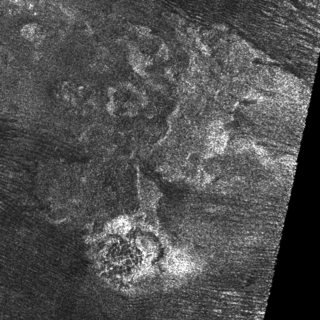
Doom Mons is the name of a mountain range and its eponymous peak on Titan, the largest moon of Saturn. A putative cryovolcano, it is the largest mountain range on Titan by volume. It was discovered by the Cassini–Huygens probe in 2005 and officially named in 2012.
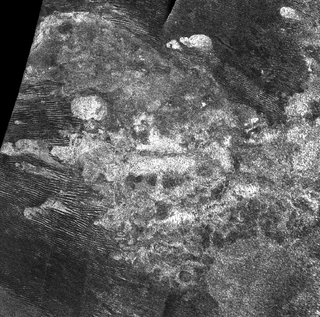
Erebor Mons is a mountain on Titan, the largest moon of the planet Saturn. It is located near Titan's equator, between 4–5° south and 35–36° west, centered on 4.97°S 36.23°W, in the western part of Quivira region. It is 40 km across, more than 1 km high, and has lobate flow features to its north and east. It is probably a cryovolcano. Erebor Mons is situated about 470 km to the north-northeast of a larger cryovolcanic construct, Doom Mons.
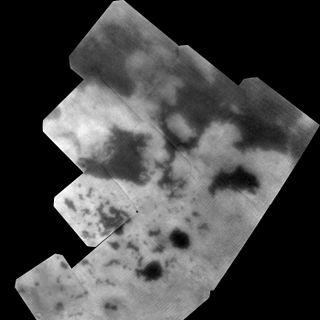
Woytchugga Lacuna is one of the largest lakes of Titan.

PateraPAT-ər-ə is an irregular crater, or a complex crater with scalloped edges on a celestial body. Paterae can have any origin, although the majority of them were created by volcanism. The term comes from Latin, where it refers to a shallow bowl used in antique cultures.
The following outline is provided as an overview of and topical guide to Saturn:
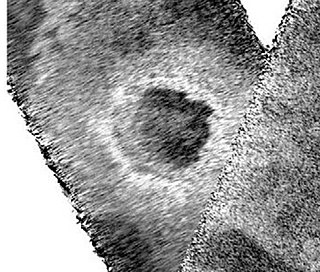
The Selk crater is a crater on Titan, a moon of Saturn, located at 7°N 199°W. It is a geologically young impact crater that measures approximately 90 kilometres (56 mi) in diameter.